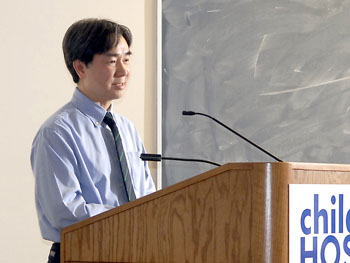Patrick Sharrock's first broken bone occurred in the womb.
In all, Patrick, 9, has sustained more than 50 breaks in his young life. He and his family are the recipients of an "Extreme Makeover: Home Edition" at their Rossville home, primarily to help him cope with the disease.
"I have lost count" of all the breaks Patrick has sustained because of his brittle-bone disease, his pediatrician, Dr. Thomas Ho of Ringgold, Ga., said at a news conference Wednesday at T.C. Thompson Children's Hospital.
Sometimes the breaks require a trip to the ER; other times Patrick's parents can treat him, applying splints at home, Ho said.
But thanks to infusions of medicines to strengthen his bones, and Patrick's experience at how to avoid hurting himself, there have been fewer breaks over time, Ho said.
The news conference offered more detail on Patrick's prognosis and background on his genetic condition, which affects between 1 in 15,000 and 1 in 20,000 people.
While Patrick is at Disney World with his family, cast members from the ABC-TV show "Extreme Makeover: Home Edition," along with thousands of local volunteers, are building a house with strong floors and rounded corners that will help keep Patrick safe.
Weighing only 36 pounds, Patrick has Type 3 osteogenesis imperfecta, Ho said. Type 3 cases typically are severe and its patients usually have somewhat shortened lifespans, his doctors said.
Dr. Wendell Moses, pediatric orthopedic surgeon at T.C. Thompson, said he is treating eight young patients with the condition.
BRITTLE BONE DISEASEType I, or mild OI, is the most common form. Those with this type can live a normal lifespan.Type II is a severe form that usually leads to death in the first year.Type III is also called severe OI. Patients have many fractures starting early in life and can have severe bone deformities. Many must use wheelchairs and usually have a shorter life expectancy.Type IV, or moderately severe OI, is similar to type I, although patients often need braces or crutches to walk. Life expectancy is normal or near normal.Source: National Institutes of Health
"In terms of genetic diseases, it's common," said Dr. Cathy Stevens, pediatric geneticist at T.C. Thompson, who has also treated Patrick.
The affected gene disrupts the body's production of collagen, which is "the glue that holds us together," in our bones, blood vessels and other connective tissues, Stevens said.
Although there is no cure, Patrick's symptoms have been mitigated by interventions, including physical and swimming therapy, which can build bone mass and strengthen bones, his doctors said.
Ho said he advised the Sharrock family to be careful in Disney World.
"Definitely no roller coasters, but he can watch the parades and go on slow-motion rides," he said.
Contact staff writer Emily Bregel at ebregel@timesfreepress.com or 423-757-6467.
Like the Chattanooga Times Free Press on Facebook and follow us on Twitter for updates all day long.


